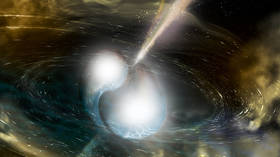Astronomers discover most MASSIVE neutron star known to man

Astronomers have detected a neutron star which beggars belief, being so big it challenges our understanding of extreme objects in the universe.
The pulsar, with the catchy name J0740+6620, is the first neutron star humans have detected measuring over two solar masses.
Using the timing of its pulses, astronomers have calculated its mass to be roughly 2.14 times that of our sun, packed into an area just 30km across (the Sun is 1.391 million km across, so it's a tight squeeze).
The object is close to the theoretical upper limit of 2.3 solar masses for a rotating neutron star, based on cutting-edge gravitational wave astronomy calculations from just last year.
Also on rt.com Astronomers studying ALIEN radio signals discover 8 NEW sources, one from nearby galaxyNeutron stars form after the immensely explosive and violent deaths of stars in a series of thermonuclear explosions that fuse every last bit of material remaining in their cores.
After this truly awe-inspiring death rattle, the remaining iron core collapses, packing whatever neutrons are left into an almost inconceivably small space, producing an object roughly as dense as an atomic nucleus.
This newly-discovered, truly massive neutron star could bridge the gap in our understanding between neutron stars and black holes (which typically form from stars above five solar masses).
J0740+6620 is located some 4,500 light-years away and is what is known as a millisecond pulsar, meaning it is rotating insanely fast, showering the Earth with bright radio waves shooting out from its magnetic poles on every pass.
Also on rt.com Kickstarter: Millions of black holes bouncing around galaxy after being booted at birth, study findsAstronomers were able to use these radio waves to determine that J0740+6620 is located in a binary system and has a white dwarf star swirling around it, which passes between us and the neutron star in what is known as a transit.
Using the slight disruptions in the pulses caused by the white dwarf's orbits, astronomers led by Thankful Cromartie of the University of Virginia and the National Radio Astronomy Observatory measured the pulsar's mass.
"These city-sized objects are essentially ginormous atomic nuclei. They are so massive that their interiors take on weird properties. Finding the maximum mass that physics and nature will allow can teach us a great deal about this otherwise inaccessible realm in astrophysics," Cromartie said.
Think your friends would be interested? Share this story!














